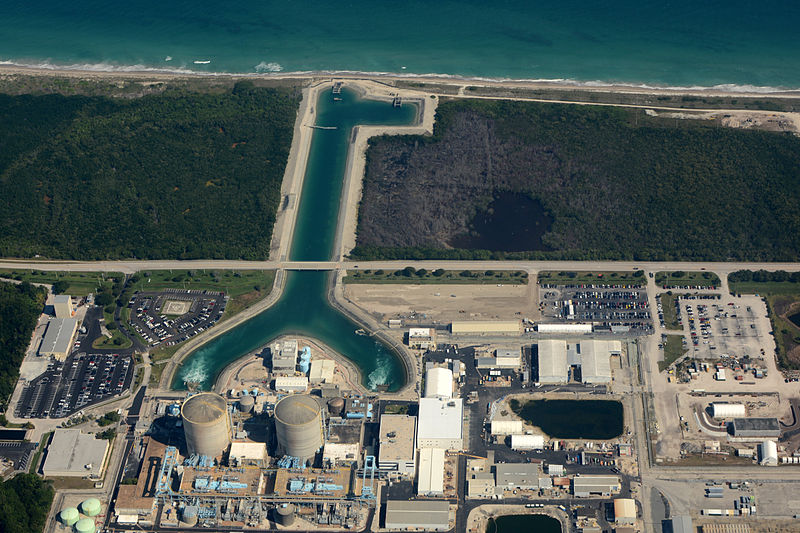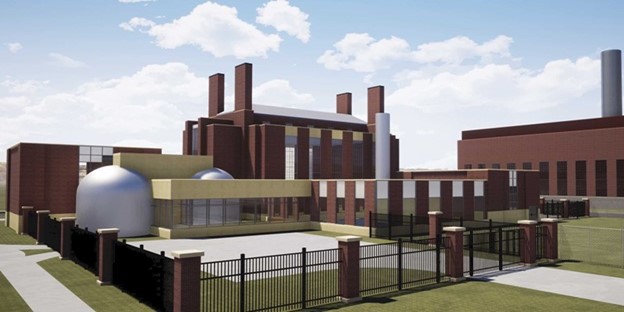Nine Mile Point (Photo: Constellation Energy)
Exelon Generation has received a grant from the Department of Energy to explore the potential benefits of on-site hydrogen production and has chosen its Nine Mile Point nuclear power plant as the demonstration site, the company announced on Wednesday. (In 2019, Exelon received a conditional commitment from the DOE to co-fund a hydrogen electrolyzer demonstration at a nuclear plant.) Located in Scriba, N.Y., Nine Mile Point consists of two boiling water reactors—the 620-MWe Unit 1 and the 1,287-MWe Unit 2.
A still image from a three-part video tour of NuScale’s facilities. (Photos: NuScale Power)
NuScale Power has signed a memorandum of understanding with Xcel Energy to explore the feasibility of the utility’s serving as a plant operator at NuScale plants, the Portland, Ore.-based small modular reactor developer announced earlier this week.
Xcel owns and, through subsidiary Northern States Power Company, operates Minnesota’s two nuclear plants, Monticello and Prairie Island. The Monticello facility houses one 671-MWe boiling water reactor, while Prairie Island has twin 550-MWe pressurized water reactors.
A color-enhanced photograph of the NIF target bay. (Photo: LLNL/Damien Jemison)
Lawrence Livermore National Laboratory is celebrating the yield from an experiment at the National Ignition Facility (NIF) of more than 1.3 megajoules of energy—eight times more than the yield from experiments conducted this spring and 25 times more than NIF’s 2018 record yield.
The magnet system of Wendelstein 7-X features 50 superconducting magnet coils. (Graphic: IPP)
The Max Planck Institute for Plasma Physics (IPP) was founded in Garching, Germany, in 1960, the same year that its Wendelstein 1a stellarator began operation. Wendelstein 7-X is now operating at IPP’s site in Greifswald, Germany, and one of the objectives the device was designed to achieve has recently been confirmed, IPP announced on August 12. Analysis by IPP scientists shows that the twisted magnetic coils of the device successfully control plasma energy losses, indicating that stellarator fusion devices could be suitable for power plants, according to a detailed analysis of experimental results published on August 11 in Nature.
St. Lucie nuclear power plant. (Photo: D Ramey Logan)
Florida Power and Light Company, a subsidiary of NextEra Energy, has filed a subsequent license renewal application with the Nuclear Regulatory Commission for the two-unit St. Lucie nuclear power plant, seeking a second 20-year renewal of the reactors’ operating licenses.
The right side of the cooling tower of MIT’s reactor has the new system installed, eliminating its plume of vapor, while the untreated left side continues to produce a steady vapor stream. (Image: MIT/courtesy of the researchers)
The white plumes of steam billowing from the cooling towers of nuclear power plants and other thermal power plants represent an opportunity to some—the opportunity to collect a valued resource, purified water, that is now lost to the atmosphere. A small company called Infinite Cooling is looking to commercialize a technology recently developed at the Massachusetts Institute of Technology by the Varanasi Research Group, whose work is described in an article written by David L. Chandler, of the MIT News Office, and published on August 3.
Chemist Kevin Gaddis has adapted components of a high-pressure ion chromatography system to withstand the extreme conditions of a hot cell. (Photo: ORNL/Carlos Jones)
An Oak Ridge National Laboratory researcher has built a device that can speed up the separation of the medical radioisotope actinium-225 from irradiated thorium targets and withstand the high-radiation environment of a hot cell. In July, ORNL announced that Kevin Gaddis, a chemistry technician at the lab, had built and tested a prototype and was working to secure a patent for a device that cut separations time by 75 percent.
Irradiated lead test rods are delivered to Oak Ridge National Laboratory for examination. (Photo: ORNL)
Several lead test rods of Westinghouse’s EnCore accident tolerant fuel recently arrived at Oak Ridge National Laboratory for post-irradiation examination over the next year in support of the Nuclear Regulatory Commission’s licensing process. The rods were installed in 2019 in Exelon’s Byron-2, a 1,158-MWe pressurized water reactor, and were removed in fall 2020 and prepared for shipment to ORNL.
Workers in the control room of the newly operational Honghanye-5 reactor. (Photo: Liaoning Hongyanhe Nuclear Power Company)
China continues its relentless march toward the top of the list of nations with the most power reactors. On July 31, China General Nuclear Power Group (CGN) announced that Unit 5 at the Hongyanhe plant in Liaoning Province has begun commercial operation, giving China 51 commercial-scale power reactors, only five fewer than France, which currently sits at the number-two spot on the list with 56 operating reactors.
A rendering of Ultra Safe Nuclear Corporation’s micro modular reactor as proposed for construction on the University of Illinois at Urbana-Champaign campus. (Graphic: USNC)
A bipartisan group of legislators has introduced a bill to invest in university nuclear science and engineering infrastructure, establish regional consortia to promote collaboration with industry and national laboratories, and support the development of advanced reactor technology. The National Nuclear University Research Infrastructure Reinvestment Act of 2021 (H.R. 4819) was introduced in the House of Representatives by Reps. Anthony Gonzalez (R., Ohio), Sean Casten (D., Ill.), Peter Meijer (R., Mich.), and Bill Foster (D., Ill).






 The Canadian Nuclear Safety Commission and the U.S. Nuclear Regulatory Commission have completed the first collaborative project under a two-year-old memorandum of cooperation (MOC) aimed at enhancing technical reviews of advanced reactor and small modular reactor technologies, the CNSC announced earlier this week.
The Canadian Nuclear Safety Commission and the U.S. Nuclear Regulatory Commission have completed the first collaborative project under a two-year-old memorandum of cooperation (MOC) aimed at enhancing technical reviews of advanced reactor and small modular reactor technologies, the CNSC announced earlier this week.









